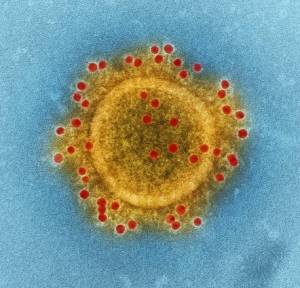
전세계는 중동 이외의 지역에서 발생한 사상 최대의 MERS 창궐사태를 예의주시하고 있다. 일반적으로 MERS 바이러스는 세계적 유행병(pandemic)을 일으킬 잠재력을 지닌 바이러스 중 하나로 간주되고 있다. 그러나 전문가들은 이번 감염 사태가 세계적 유행병으로 비화할 가능성은 낮다고 보고 있는데, 그 근거는 다음과 같다.
1. MERS 바이러스는 인간 바이러스(인간 사이에서 전염되는 바이러스)가 아니다.
하나의 바이러스가 세계적으로 유행하려면, 사람 사이에서 쉽게 전염될 수 있어야 한다. 그러나 2012년 사우디아라비아에서 처음 발견된 MERS 바이러스는 주로 동물 바이러스(동물 사이에서 전염되는 바이러스)다. 그것은 박쥐에게서 유래한 것으로 생각되며, 간혹 동물매개자((아마도 낙타)를 통해 인간을 감염시키곤 한다.
MERS 바이러스는 - 이번 한국의 경우처럼 - 어쩌다 인간 사이에서도 전염될 수 있지만, 두 가지 전제조건이 필요하다. 첫 번째 조건은 `병원 내`라는 상황이며(자세한 내용은 아래 참조), 두 번째 조건은(첫 번째 조건보다 가능성은 낮지만) `가정 내`라는 상황이다. 두 가지 조건의 공통점은 `환자와 의료인(또는 간병인)이 밀접하게 접촉한다`는 것이다.
이번 사태는 중동 4개국을 방문한 68세 노인이 5월 4일 귀국하면서부터 시작되었다. 그는 MERS로 확진받기 전에 4개 병원을 전전하며 보건의료 종사자, 가족, 기타 환자들을 감염시켰다. MERS가 세계적으로 유행하려면 돌연변이를 획득하여 사회 구성원들 사이에서 쉽게 전파될 수 있어야 한다. 그러나 역학정보와 바이러스 유전체 분석결과에 의하면, 현재 한국에서 문제를 일으키고 있는 바이러스에게서 특이사항은 발견되지 않았다.
2. MERS 바이러스는 주로 병원에서 전파되고 있다.
MERS 바이러스는 인간 바이러스는 아니지만, 간혹 인간 바이러스처럼 행동하는 장소가 한 군데 있다. 그곳은 병원이다. 병원에서는 미진단환자(undiagnosed patient)를 처치하는 과정에서 호흡을 돕기 위해 기도에 관을 삽입하는 경우가 있는데, 이 경우 환자의 폐에서 비말이 발생하여 주변을 오염시켜 인근의 사람들을 바이러스에 감염시킬 수 있다. 그러지 않고서는 폐 깊숙이 있는 MERS 바이러스가 기침을 통해 밖으로 나오기 힘들다. 이번 사태의 경우, 최초 감염자가 5월 11일 감기 유사증상을 호소하며 기침을 했지만, MERS로 확진받아 격리된 것이 5월 20일이다. 이 기간 동안 감염을 통제하기 위한 예방초치가 취해지지 않아 다른 사람들을 감염시킬 시간여유(time window)를 제공했다고 설명할 수 있다. 또한 확진을 받기 전에 네 군데 병원을 전전한 것도 감염의 위험을 증가시켰다.
3. MERS와 SARS는 다르다
혹자는 2003년 전세계를 휩쓴 SARS를 연상하는 모양이다. 물론 SARS는 종국에 진압되었지만, MERS와 SARS가 근본적으로 다른 점이 하나 있다. 그것은 "SARS 바이러스는 대인(對人)감염력을 진화시켰지만 MERS 바이러스는 그러지 못했다"는 것이다. 그렇다면 혹시 MERS 바이러스가 SARS와 비슷한 세계적 유행병을 일으키도록 진화하지는 않을까? 글쎄다. 바이러스라는 것이 워낙 예측불가능해서, 그럴 가능성을 배제할 수는 없다. 하지만 꼭 그럴 거라고 단정할 필요는 더더욱 없다. 중국과 한국의 과학자들이 바이러스 유전체를 분석한 바에 의하면, 다행히 아직까지 특이한 돌연변이는 포착되지 않았다고 한다.
4. 이번 사태의 규모가 예외적으로 큰 것은 아니다.
이번 사태는 중동 외부에서 일어난 사태 중 최대지만, 규모가 예외적으로 큰 것은 아니다. 예컨대 2014년 봄 사우디아라비아 제다에서는 255명이 감염된 바 있다. 게다가 한국의 감염자 수는 중동의 경우보다 부풀려졌을 가능성이 높다. 왜냐하면 한국 보건당국이 접촉자들을 광범위하게 검사하다 보니 경미한 환자들까지 확진판정을 받았지만, 과거 중동의 경우 경미한 환자들은 간과되었을 가능성이 높기 때문이다.
5. 한국 보건당국이 잘 대응하고 있다.
※ 출처: Nature News, `South Korean MERS outbreak is not a global threat", 05 June 2015.
http://www.nature.com/news/south-korean-mers-outbreak-is-not-a-global-threat-1.17709
South Korean MERS outbreak is not a global threat
The largest outbreak of the MERS coronavirus outside the Middle East is no different to previous outbreaks in the way that it spreads.
Declan Butler
05 June 2015 Corrected: 08 June 2015

The world is watching as the largest outbreak of Middle East Respiratory Syndrome (MERS) outside the Middle East continues in South Korea. According to the most recent figures from the World Health Organization, 30 people have been infected, two of whom have died. Hundreds of schools have been closed. The causal coronavirus, MERS-CoV, is one of many viruses that are considered potential pandemic threats. But experts do not consider this outbreak, in which all cases are hospital-associated, to have pandemic potential or even expect it to spread further within South Korea. Here are some of the reasons why.
MERS is not a human virus
For a virus to go pandemic, it must be able to spread easily between people, but MERS-CoV, which was first detected in Saudi Arabia in 2012, is primarily an animal virus. It is thought to have originated in bats, and occasionally jumps to humans through animal intermediates, probably camels. The virus can occasionally spread between people, as happened in South Korea, but only in hospital settings (for more, see below), or to a much lesser extent in households where people caring for an infected person have had close contact. The current outbreak was sparked when a 68-year-old Korean man flew back to Seoul on 4 May after a visit to four Middle Eastern countries. Before he was diagnosed, he spread the virus to health-care workers, family members, and other patients at the four different health-care facilities in which he was treated. To go pandemic, MERS-CoV would need to mutate so that it could spread easily between humans in the wider community — but the epidemiological information shows that the outbreak in South Korea is not unusual.
MERS mainly spreads in hospitals
Though MERS-CoV is not considered a human virus, there is one place where it sometimes behaves like one: hospitals. In these settings, medical procedures on an undiagnosed patient, for example to aid breathing, can generate aerosols from the lungs that contaminate the area and infect people nearby with the virus. Otherwise, MERS-CoV which infects the deeper areas of the lung, is not coughed out. In this outbreak, the source developed flu-like symptoms and a cough on 11 May, but was only diagnosed and isolated on 20 May. This created a time window during which no special infection-control precautions were taken, which explains how he transmitted the infection. That he was treated at four different health facilities before he was diagnosed multiplied the risk of infection.
South Korea is doing a great job
Because it spreads very poorly between people, MERS-CoV can be controlled by public-health measures, which South Korean authorities are now pursuing aggressively. The authorities have been exceptionally thorough in tracing all contacts of infected people and monitoring them for 14 days — the maximum incubation period of the disease. Any who begin to show symptoms are isolated. So far, all new cases have been among listed contacts, adding to confidence that the outbreak is under control. There are new cases reported each day but these do not represent any new spread of the virus since they can be accounted for by the more than 1,600 contacts of those already infected before MERS-CoV was diagnosed in South Korea.
MERS is not SARS

Over the past week, some may have been reminded of Severe Acute Respiratory Syndrome (SARS), which swept the globe in 2003. Even that was eventually brought under control, but it was different to MERS in one very important way: the coronavirus that caused SARS had evolved the ability to spread more easily between people than MERS does. MERS-CoV by contrast has not. Might MERS-CoV similarly evolve to cause a SARS-like outbreak? Viruses are unpredictable, so that possibility cannot be excluded, but nor is it inevitable. As is routine in such outbreaks, the virus will be sequenced to look for any genetic changes. But given that there is nothing extraordinary in the pattern of spread in the South Korean outbreak, there is no need to invoke hypothetical evolution. Were cases springing up around South Korea outside of hospital settings, that would be cause for alarm — but they are not.
This outbreak is not that big
This outbreak may be the largest outside the Middle East, but it is not exceptional in size. An outbreak in Jeddah in Saudi Arabia during the spring of 2014 resulted in 255 people becoming infected, and a cluster of infections in 2013 at a hospital in Al-Hasa, in eastern Saudi Arabia, resulted in 23 confirmed and 11 suspected cases. Dozens of other hospital outbreaks have occurred in Saudi Arabia, prompting the health authorities there to retrain the hospital workforce in infection control. The number of those infected in the South Korean outbreak is also likely to be inflated because the authorities have comprehensively tested contacts for virus, and so have probably picked up many mild cases that may have gone undetected in past hospital outbreaks.
Nature doi:10.1038/nature.2015.17709
